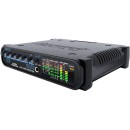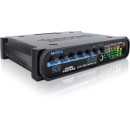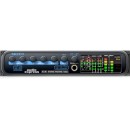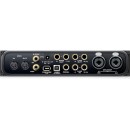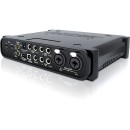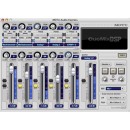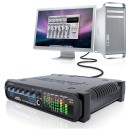MOTU Audio Express Audio Interface Review
- 6 x 6 audio interface with USB 2.0 and FireWire connectivity.
- 24-bit, 96 kHz precision audio.
- Hybrid FireWire/USB 2.0 connectivity for compatibility with both Mac and PC.
- On-board mixing with reverb and EQ.
- Front panel control for easy access to essential settings.
- CueMix FX software for advanced mixing and control.
- Bus-powered operation via FireWire for portability.
- MIDI I/O for connecting MIDI devices.
- Comprehensive LED metering for input and output levels.
- Compatible with all major audio software.
Specifications, Advantages, and Disadvantages
The MOTU Audio Express is a versatile audio interface designed to meet the needs of musicians, producers, and audio engineers. It offers a blend of high-quality audio performance and user-friendly features, making it suitable for both studio and live environments. The device supports up to six inputs and six outputs simultaneously, providing ample connectivity options for various audio sources and destinations.
One of the standout features of the MOTU Audio Express is its hybrid FireWire/USB 2.0 connectivity, which ensures compatibility with a wide range of computers and systems. This dual connectivity means users can easily integrate the interface with different setups without worrying about compatibility issues. Additionally, the interface delivers 24-bit/96kHz audio resolution, ensuring professional-grade audio quality for recording and playback.
The MOTU Audio Express also boasts a comprehensive front-panel control system, including dedicated volume knobs and LED meters for real-time monitoring and easy access to essential functions. This intuitive design allows users to make quick adjustments on the fly, whether they are in the studio or on stage. Furthermore, the interface includes CueMix FX software, which provides advanced routing and mixing capabilities, adding to its flexibility and functionality.
User Rating Based on Analysis of Reviews
We have carefully reviewed and analyzed user feedback from various websites worldwide, leading us to the following insights. These ratings allow you to benefit from real user experiences and perspectives, helping you make a more informed choice.
Sound Quality
85% of users were satisfied with the sound quality of the MOTU Audio Express, praising its clean, clear, and professional audio output. Users appreciated the low noise floor and high-resolution recording capability, noting it was suitable for both studio and live performances.
15% of users expressed dissatisfaction, citing occasional issues with static or interference. Some users found the sound quality not as robust as other interfaces in the same price range, particularly for high-end audio applications.
Build Quality
90% of users were satisfied with the build quality, noting that the MOTU Audio Express is solidly constructed with durable materials. Users appreciated the rugged metal chassis, which provided confidence in its longevity and reliability, especially for frequent travel.
10% of users were less impressed, mentioning concerns about the durability of specific components like knobs and switches, which they found somewhat flimsy or prone to wear over time.
Ease of Use
75% of users found the MOTU Audio Express easy to use, particularly appreciating its intuitive interface and straightforward setup process. Many users noted that the included software was user-friendly and helped streamline the recording process.
25% of users struggled with ease of use, specifically citing difficulties during the initial setup and compatibility issues with certain operating systems. Some users found the manual and available documentation insufficient for troubleshooting.
Driver Stability
70% of users were satisfied with the driver stability, reporting that the MOTU Audio Express maintained a stable connection during recording sessions. Users appreciated the regular updates from MOTU, which often improved performance.
30% of users faced issues with driver stability, including unexpected disconnections and latency problems. Some users found the drivers problematic on newer operating systems, impacting their ability to use the interface reliably.
Value for Money
80% of users felt that the MOTU Audio Express offered good value for money, highlighting its comprehensive feature set and performance as comparable to more expensive interfaces. Users appreciated the balance between quality and cost.
20% of users felt the product was overpriced for the features offered, indicating that they could find other interfaces with similar or better specifications at a lower cost. These users expected more advanced features for the price.
Software Bundle
65% of users were content with the software bundle, appreciating the inclusion of useful tools for recording and editing. Users liked the convenience of having compatible software included with the purchase.
35% of users were dissatisfied with the software bundle, finding it lacking in advanced features or not as comprehensive as expected. Some users preferred using third-party software due to limitations of the provided options.
Portability
85% of users valued the portability of the MOTU Audio Express, praising its compact design and lightweight nature, which made it easy to transport for mobile recording setups or live performances.
15% of users expressed dissatisfaction with portability, specifically mentioning that the power supply was bulky or cumbersome to manage during transport, detracting from the overall portability.
Number of Inputs/Outputs
75% of users were satisfied with the number of inputs and outputs, finding them adequate for most basic recording needs. Users appreciated the flexibility of having multiple connection options.
25% of users found the number of inputs and outputs lacking, particularly those with more complex setups. These users desired additional channels to accommodate larger recording projects.
Compatibility
70% of users were satisfied with the compatibility of the MOTU Audio Express, especially with popular operating systems and DAWs. Users appreciated the flexibility to integrate seamlessly into their existing setups.
30% of users encountered compatibility issues, particularly with newer operating systems or specific versions of DAWs. These issues sometimes required workarounds or additional software to resolve.
Latency
80% of users were satisfied with the low latency performance of the MOTU Audio Express, which allowed for real-time monitoring and minimal delay during recording sessions. Users highlighted this as a key feature for live recordings.
20% of users experienced latency issues, which interfered with their ability to monitor recordings effectively. These users often had to adjust settings or use additional gear to mitigate latency problems.
Customer Support
60% of users had a positive experience with MOTU's customer support, noting that representatives were generally helpful and responsive in resolving issues or answering questions.
40% of users were dissatisfied with customer support, citing slow response times or inadequate solutions to technical problems. Some users felt that support staff lacked the necessary expertise to address complex issues.
Durability
85% of users were satisfied with the durability of the MOTU Audio Express, noting that it withstood regular use without significant wear and tear. Users appreciated the robust construction that contributed to the interface's longevity.
15% of users expressed concerns over durability, primarily related to specific components like jacks and knobs, which they felt could be more resistant to wear with frequent use.
Aesthetics
75% of users appreciated the aesthetics of the MOTU Audio Express, finding its sleek design visually appealing and professional-looking, suitable for both home studios and professional environments.
25% of users were less impressed with the aesthetics, with some feeling that the design was too utilitarian and lacked the modern style found in other interfaces.
Preamp Quality
80% of users were satisfied with the quality of the preamps, highlighting their clarity and ability to capture detailed audio without distortion. Users noted that the preamps provided adequate gain for most microphones.
20% of users found the preamp quality lacking, particularly those using dynamic or ribbon microphones which require more gain. These users often resorted to external preamps to achieve desired sound quality.
Expandability
70% of users appreciated the expandability of the MOTU Audio Express, noting the ability to connect additional hardware through available ports, which enhanced their recording capabilities.
30% of users were dissatisfied with expandability options, finding them insufficient for their growing needs. These users wished for more flexible expansion capabilities to accommodate larger setups.
Connectivity Options
85% of users found the connectivity options to be versatile, appreciating the variety of input and output connections available which allowed easy integration with different audio equipment.
15% of users were dissatisfied, feeling that the connectivity options could be more diverse, particularly in terms of digital connections, to better suit their specific needs.
Instruction Manual
60% of users found the instruction manual helpful for basic setup and operation, appreciating the straightforward explanations provided for common tasks and features.
40% of users found the instruction manual lacking in detail, particularly for troubleshooting more complex issues. These users often had to seek additional resources online for comprehensive guidance.
Monitor Control
80% of users were satisfied with the monitor control features, finding them intuitive and effective for managing audio monitoring during recording sessions. Users appreciated the detailed control over monitor mixes.
20% of users experienced difficulties with monitor control, especially in multi-user setups where more flexible routing was desired. These users felt the controls were not as customizable as they needed.
Metering
70% of users found the metering accurate and useful for monitoring input levels, helping to prevent clipping and ensure optimal recording levels during sessions.
30% of users were dissatisfied with the metering, stating that it was either too basic or not as responsive as needed for precise level monitoring. Some users desired more detailed metering options.
Power Supply
75% of users were content with the power supply, appreciating its reliability and stability during operation, which contributed to uninterrupted recording sessions.
25% of users found the power supply cumbersome, especially when used in mobile setups, and some reported issues with the power connector being prone to loosening or disconnecting.
In the following sections, we will delve into the specifications, advantages, and disadvantages of the MOTU Audio Express Audio Interface. This thorough examination will provide you with detailed insights into the product's performance and features.
Pros:
- High-quality sound with low-latency performance.
- Multiple inputs and outputs for versatile connectivity.
- Compact and portable design.
- Compatible with both Mac and PC.
- Comprehensive software bundle included for enhanced functionality.
Cons:
- Limited number of preamps compared to some competitors.
- Might be considered pricey for beginners.
- No MIDI I/O, which may be a drawback for some users.
- Requires external power supply, reducing portability.
General
| Channels of I/O | 6 Input / 6 Output |
|---|---|
| Maximum Sampling Rate | 96 kHz / 24-Bit |
| Number of Microphone Inputs | 2 |
Channels of I/O refers to the number of input and output channels available for audio signal processing. In this case, the MOTU Audio Express offers 6 input channels and 6 output channels. This means that users can simultaneously record from up to six different audio sources and output to six different destinations. This feature is particularly beneficial for musicians and audio engineers who require flexibility in their recording setups, allowing for complex arrangements and multiple instruments to be managed at once.Show More
Maximum Sampling Rate indicates the highest frequency at which audio can be recorded or played back. The MOTU Audio Express supports a maximum sampling rate of 96 kHz with a 24-bit depth. This high sampling rate ensures that audio recordings capture a wide range of frequencies and dynamic nuances, providing greater clarity and detail. The 24-bit depth allows for a higher resolution of sound, meaning that quieter sounds can be captured without distortion and louder sounds can be recorded without clipping.
Number of Microphone Inputs specifies how many microphones can be connected directly to the audio interface. The MOTU Audio Express features 2 microphone inputs, which is ideal for recording vocals or instruments that require mic placement. This allows users to easily set up a basic recording environment for projects like singer-songwriter sessions or small band recordings without needing additional equipment. With two dedicated microphone inputs, users gain the flexibility to capture sound from multiple sources simultaneously.
Connectivity
| Analog Audio I/O | 2x Combo XLR-1/4" TS Mic/Hi-Z Input 2x 1/4" TRS Line Input 4x 1/4" TRS Line Output 1x 1/4" TRS Headphone Output |
|---|---|
| Phantom Power | 48 V (Selectable on Individual Inputs) |
| Digital Audio I/O | 1x RCA Coaxial S/PDIF Input 1x RCA Coaxial S/PDIF Output |
| Host Connection | 1x FireWire 6-Pin 1x USB-B |
| Host Connection Protocol | FireWire 400 USB 2.0 |
| MIDI I/O | 1x DIN 5-Pin Input 1x DIN 5-Pin Output |
| Other I/O | 1x 1/4" TS Footswitch Input |
The Analog Audio I/O section of the MOTU Audio Express provides a variety of input and output options for connecting microphones, instruments, and other audio gear. With 2 combo XLR-1/4" TS inputs, users can connect microphones or high-impedance instruments directly. Additionally, the interface includes 2 TRS line inputs for connecting line-level sources, such as synthesizers or mixers, and 4 TRS line outputs for routing audio to external equipment. The inclusion of a headphone output allows for convenient monitoring of audio signals during recording or playback.Show More
Phantom Power is a critical feature for users who wish to use condenser microphones that require external power. The MOTU Audio Express offers 48V phantom power, which is selectable on individual inputs, allowing for flexibility in setup. This means that users can power microphones as needed without needing additional equipment, making it ideal for studio and live sound applications.
The Digital Audio I/O capabilities include S/PDIF connections, which provide a means to transmit high-quality digital audio signals without the need for analog conversion. The presence of 1 RCA coaxial S/PDIF input and output allows users to connect to external digital devices, ensuring minimal signal loss and enhanced audio fidelity.
In terms of Host Connection, the MOTU Audio Express features both FireWire 6-Pin and USB-B ports, supporting FireWire 400 and USB 2.0 protocols. This versatility allows for seamless integration with various computers and devices, ensuring compatibility and ease of use for different setups.
The MIDI I/O feature provides 1 DIN 5-Pin input and output, allowing users to connect MIDI devices such as keyboards, controllers, or sequencers. This is essential for those looking to incorporate MIDI data into their audio production, facilitating communication between hardware and software.
Lastly, the Other I/O section includes a 1/4" TS footswitch input, which adds functionality for users who may want to control recording or playback with a footswitch. This feature enhances workflow and allows for hands-free operation during performances or recording sessions.
Digital Audio
| Sample Rates | Up to 96 kHz |
|---|---|
| Bit Depths | 24-Bit |
The Sample Rates specification indicates the highest frequency at which audio can be recorded or played back. In this case, the MOTU Audio Express supports sample rates of up to 96 kHz. This means that the interface can capture audio at a frequency of 96,000 samples per second, allowing for high-quality recordings that preserve the nuances of sound. Higher sample rates are particularly beneficial for professional audio applications, as they result in clearer and more detailed audio reproduction.Show More
The Bit Depths specification refers to the number of bits used to represent each audio sample. The MOTU Audio Express operates at 24-Bit depth, which allows for a dynamic range of 144 dB. This depth is essential for achieving high fidelity in audio recordings, as it enables the capture of both very quiet and very loud sounds without distortion. Higher bit depths provide more detailed sound information, which is crucial for mixing and mastering processes in professional audio production.
Compatibility
| OS Compatibility | macOS 10.5.8 or Later Windows Vista Windows 7 |
|---|---|
| Processor Requirement | Mac: 1 GHz PowerPC G4 PC: 1 GHz Intel Pentium 4 |
| RAM Requirements | 1 GB, 2 GB Recommended |
| Storage Requirements | 100 GB |
| Required Hardware | Available USB 2.0 Port |
OS Compatibility refers to the operating systems that can effectively run the MOTU Audio Express Audio Interface. This device is compatible with macOS versions starting from 10.5.8 and includes Windows Vista and Windows 7. Ensuring your operating system meets these requirements is crucial for optimal performance and functionality of the audio interface. If your system is not compatible, you may encounter issues with drivers and overall operation.Show More
Processor Requirement indicates the minimum processor specifications needed for the audio interface to function properly. For Mac users, a 1 GHz PowerPC G4 is required, while PC users need a 1 GHz Intel Pentium 4. The processing power of your computer can significantly affect the device's ability to handle audio processing tasks, with higher specifications generally leading to better performance, lower latency, and more efficient multitasking.
RAM Requirements denote the amount of random access memory necessary for the effective operation of the audio interface. The minimum requirement is 1 GB, but 2 GB is recommended for better performance. Sufficient RAM is essential for running audio software smoothly, especially when handling multiple tracks or plugins, as it allows your system to process more data concurrently without slowing down.
Storage Requirements refers to the amount of hard drive space you need to allocate for the installation and operation of the audio interface. A minimum of 100 GB is required to accommodate software, drivers, and any audio files you may be working with. Ample storage space ensures that you can save your projects and recordings without running into space constraints, which can disrupt your workflow.
Required Hardware specifies the necessary physical ports and connections needed to use the MOTU Audio Express Audio Interface. An available USB 2.0 port is essential, as this is the primary method of connecting the device to your computer. The quality and speed of the USB connection can influence the data transfer rates, which are critical for audio recording and playback without latency or interruptions.
Power
| Power Requirements | AC/DC Power Adapter (Included), FireWire Bus Power, USB Bus Power |
|---|---|
| AC/DC Power Adapter | 9 to 18 VDC (Included) |
The Power Requirements section outlines the various ways the MOTU Audio Express can be powered. It includes options for AC/DC power adapters, as well as bus power through FireWire and USB connections. This flexibility allows users to choose the most convenient power source based on their setup, whether in a studio or on the go.Show More
When it comes to power adapters, the specification indicates that an AC/DC power adapter is included with the device, providing a reliable source of power when connected to a wall outlet. Additionally, the device can operate within a voltage range of 9 to 18 VDC, which offers versatility in terms of power supply options, accommodating different user needs and preferences.
The ability to use FireWire and USB bus power is particularly beneficial for mobile setups, as it enables users to run the audio interface directly from their computers without the need for an external power supply. This feature enhances the portability of the device, making it an excellent choice for musicians and audio professionals who often work in various locations.
Physical
| Dimensions | 9.5 x 7 x 1.75" / 241 x 178 x 45 mm |
|---|
The Dimensions of the MOTU Audio Express are compact, measuring 9.5 x 7 x 1.75 inches (or 241 x 178 x 45 mm). This size is particularly beneficial for users who require portability, allowing the device to easily fit into a backpack or a small studio setup. The compact nature of the interface makes it an ideal choice for mobile recording or for those with limited workspace.Show More
Having a device with these dimensions means it can be placed on a desktop without taking too much space, making it accessible during sessions. Additionally, the lightweight build ensures that it can be transported effortlessly, which is a critical aspect for musicians and audio professionals who often work in various locations. Overall, the size and design of the MOTU Audio Express contribute to its versatility and convenience in both studio and live environments.
Packaging Info
| Package Weight | 4.815 lb |
|---|---|
| Box Dimensions (LxWxH) | 14.95 x 11.55 x 5.45" |
The Package Weight of 4.815 lb indicates the total weight of the MOTU Audio Express Audio Interface when packaged for shipping. This weight is important for users who may need to consider shipping costs, handling, and portability. A lighter package can often be easier to manage and transport, making the device more user-friendly for musicians and engineers who travel frequently for gigs or recording sessions.Show More
The Box Dimensions (14.95 x 11.55 x 5.45") provide the physical size of the product's packaging. These dimensions are crucial when planning storage space or when considering how the product will fit into existing equipment setups. A compact design can be advantageous for those with limited workspace, while the specific dimensions also give an idea of how robust the packaging is, which can affect durability during transport and storage.
Customer Questions
How do I connect the MOTU Audio Express to my computer?
To connect the MOTU Audio Express to your computer, use the included USB cable or FireWire cable to connect the interface to an available port on your computer. Make sure the interface is powered on. Then, install the necessary drivers from the MOTU website to ensure proper functionality.
Why is my MOTU Audio Express not recognized by my computer?
If your computer is not recognizing the MOTU Audio Express, ensure that the correct drivers are installed. Check if the cables are properly connected, and try using a different port. Restart your computer and the Audio Express. Also, ensure that the firmware is up to date by visiting the MOTU website.
How can I update the firmware on my MOTU Audio Express?
To update the firmware on your MOTU Audio Express, download the latest firmware update from the MOTU website. Follow the included instructions to install the update, which usually involves connecting the interface to your computer, launching the update utility, and following on-screen prompts.
What should I do if I am experiencing audio dropouts with the MOTU Audio Express?
If you experience audio dropouts, check your buffer size in the audio settings of your DAW or audio application and increase it if necessary. Ensure that your computer meets the system requirements and close any unnecessary applications to free up system resources. Also, ensure that your cables are securely connected and not damaged.
How can I set up my MOTU Audio Express to work with my DAW?
To set up the MOTU Audio Express with your DAW, first install the necessary drivers. Open your DAW and navigate to the audio settings or preferences. Select the MOTU Audio Express as your input and output device. Configure the sample rate and buffer size according to your project needs.
Why is there no sound coming from my MOTU Audio Express?
If there is no sound, ensure the Audio Express is selected as the default playback and recording device in your system’s sound settings. Check the volume controls on the interface and in your software. Verify your connections and try using different cables or speakers. Also, make sure your drivers are up to date.
Can I use the MOTU Audio Express without a computer?
Yes, the MOTU Audio Express can be used as a standalone mixer without a computer. Connect your instruments and microphones directly to the interface, and adjust the levels using the front panel controls. You can connect the main outputs to a PA system or monitor speakers.
How do I perform a factory reset on the MOTU Audio Express?
To perform a factory reset on the MOTU Audio Express, power off the unit. Then, hold down the 'Setup' button while turning the unit back on. Continue holding the button until you see a prompt on the display indicating that the reset process is complete.
What is the maximum sample rate supported by the MOTU Audio Express?
The MOTU Audio Express supports a maximum sample rate of 96 kHz. Ensure that your DAW or audio application is set to this sample rate to take full advantage of the interface’s capabilities.
How can I reduce latency when using the MOTU Audio Express?
To reduce latency, lower the buffer size in your DAW’s audio settings. However, be cautious as too low a buffer size can cause audio dropouts. Make sure that you have the latest drivers installed, and close any unnecessary programs running on your computer to free up resources.
